The most important thing to maintaining production for a weekly blog, trumping all else, is having a topic to ramble about. There is a simple test: would talking about this subject lead to significant problems with your significant other? I know how to keep physics discussions under two minutes with my wife. She does enjoy going to Le Lyonnais, a superb French restaurant in my suburban town, to celebrate a physics result like using hypercomplex numbers to resolve the spin 2 current coupling issue. Our next tentatively scheduled visit hinges on not seeing the Higgs in a vast sea of bottom-antibottom possibilities between 120 to 145 GeV.
Click or skip this reading of the blog.
This is a personal research blog. I may run out of ideas worth sharing. It is not like a blog about the National Football League, with its predictable ebb and flow of the season. I have to rummage around my own mind, dust off ideas, then make sure I can show they make sense. It is good I stored away 14 years of such meanderings with quaternions.
The technology used to produce blogs, videos, and future book all have a guiding theme: speed. Fast is the most important quality of any technical choice. Most of the work is done on a Mac Mini - $1.3k. I do have a Linux box that produces the quaternion animations. Several key video tools are Mac only.
Blog Tools
Here is a list of what I use to write the blog, in rough time order.
GQueues.com - $25/year.
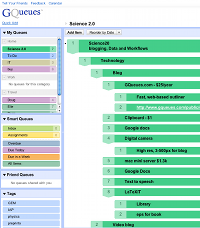 This is a fast, web-based outliner. It is essential to order the subjects in a blog in a rational way, even if that is not the order they are generated. Rearranging is quick. When on an item, type the number where it belongs. There are single letter shortcuts for most operations, like 'i' for another item or 's' for a new subtask.
This is a fast, web-based outliner. It is essential to order the subjects in a blog in a rational way, even if that is not the order they are generated. Rearranging is quick. When on an item, type the number where it belongs. There are single letter shortcuts for most operations, like 'i' for another item or 's' for a new subtask.Clipboard and Post-It Notes - $1. The first draft is written out longhand on a clipboard, often at Jam Time, a gym for my daughter. I keep a single page printout of the outline in hand. The post-its are generated as they happen, mornings in particular. Drafts get tossed away since it would require too much effort to file them.
Google Docs - free.
 Fear of the first line is avoided by always using the same format: "This is a dramatic reading of 'Blog on Weekly Blogging', a blog by the Stand-Up Physicist available on Science20.com." The drafts are published on the web.
Fear of the first line is avoided by always using the same format: "This is a dramatic reading of 'Blog on Weekly Blogging', a blog by the Stand-Up Physicist available on Science20.com." The drafts are published on the web.Text to Speech - Free. Both Mac and Linux can translate text into robo-speech. I bet there is an app for that, and a web site too. This helps me hear errors that need to be addressed. I do this 2-6 times per blog.
Text to Speech - Free. I read the post out loud. Since speaking uses different parts of the brain, different flaws are found, particularly awkward sentences. I have skipped this step about a third of the time.
Techno-doodles - $20. This is something I should do more: simple figures with technical messages. An outline is done in pencil, with ample use of the eraser, in a 5H led which is light and easy to hide later. Then I add ink or go to a B pencil. If color would aid the message, I have pastels, pencils, markers, and crayons, which ever makes the most visual sense.
Lumix DMC-FZ28K - $310. Since the photos will get reduced for the web site to 200-600 pixels, any digital camera will do.
LaTeXiT - $25 (Mac).
The end result is a blog with text and pictures available in the early AM every Tuesday.
The videoblog starts after the Science20 blog has been released.
Cheap props - $0. I used to spend a month making props for episodes of The Stand-Up Physicists, shown only on Auburn Community TV, an obscure outlet. Now all I do is write on napkins and wave a book at the camera.
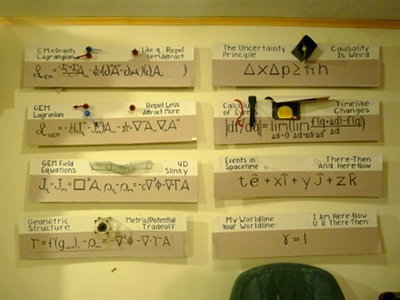
28 Inch Monitor with Wall Mount - $500. This is my teleprompter. I pull it out from the wall, get to full screen mode, make the font huge, then page through the Science20 print form of the blog, free of Celebrity TV ads.
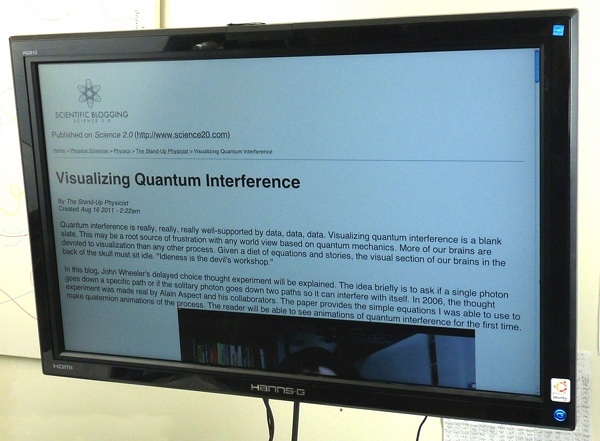
Fluorescent Light Kit - $170.
 I have a 1500 watt halogen light kit, but those ran so hot I melted the insulation on one of the basement pipes. The fluorescent lights use less electricity and are cool. I was cheap and did not get a light box, so the bulbs can be seen in the reflections of my glasses.
I have a 1500 watt halogen light kit, but those ran so hot I melted the insulation on one of the basement pipes. The fluorescent lights use less electricity and are cool. I was cheap and did not get a light box, so the bulbs can be seen in the reflections of my glasses.Panasonic HDC-SD1 - $760. I do have a higher quality video camera, but it uses tape which requires more effort to download to the computer. I chose this one out of a crowded field because it had the best microphones. A bad sound track means a bad video.
Motion - $50 (Mac). Used for the title and end credits. I only change the title, then export, a 5 minute job.
YouTube - free.
The video is a merger of the title sequence, body of the talk, plus the credits. If I stumble, I put a hand up in front of the camera to mark the botch, and delete that part of the video. Images, videos, and sound effects are added as needed.
The book is the last output from this blogging effort. The drive only started in the last month. I knew that LaTeX can be used to make a professional looking book, with a table of contents, footnotes, and an index, but the resulting documents are often visually dull, a stream of words, since that is what most technical papers are. There was a LaTeX format inspired by Edward Tufte, the big name in information design. Buy and study his books.
Github.com - free (if public). The chapter drafts and the accompanying software is being stored there. I wrote a program in Perl to merge the chapters. A chapter stays at a digestible size of 6-10 pages, while the book continues to grows too big to be dealt with efficiently. My software finds all .lyx files, removes the header and footer, and creates one big book_of_blogs.lyx file. Notes about technical details are there too for those who wish to investigate that possibility for their own work.
Blurb.com
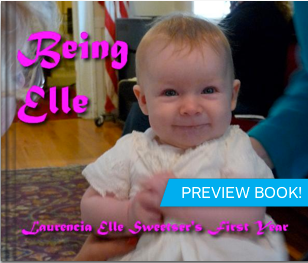 - $60/250 page color softcover book. These folks will be my printer. They already have printed two of my books: "Being Elle: Laurencia Elle Sweetser's First Year" and "A Young Man Watches a Young War", a journal my 25 year-old grandfather kept while in Paris in October, 1, 1914, about to bike to the front lines. Oops, well, apparently he did survive. Both are free to flip through in their entirety.
- $60/250 page color softcover book. These folks will be my printer. They already have printed two of my books: "Being Elle: Laurencia Elle Sweetser's First Year" and "A Young Man Watches a Young War", a journal my 25 year-old grandfather kept while in Paris in October, 1, 1914, about to bike to the front lines. Oops, well, apparently he did survive. Both are free to flip through in their entirety. Blog Time
Blogging takes time. I estimate I put in 20-25 hours per week. I work the late shift, starting at 9 PM, going to 1-3 AM. Lunch time can be blog time. Here is a visual representation of the time line, with the sizes correlated to the amount of time spent on the task.
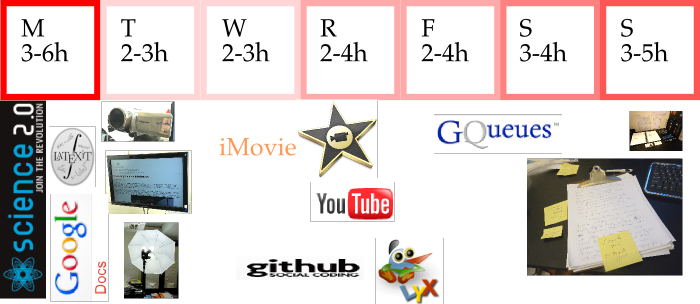
Feedback
Start with the null feedback, the sound of silence. There has been zero sales of the "No Stinkin' Higgs" t-shirt since the blogging started (there were sales to report to the IRS before). The Google Plus hangout has led to one discussion. It was a good one, so I will keep that channel open for the time being. No one tenure track or above has contacted me about this work.
The number of views on Science20 swamps those on YouTube by approximately an order of magnitude. The market response to these two channels is why doing a good job on the Science20 blog takes precedence over the videoblog. I expect any book to sell less than ten copies as my other books have. Zero marketing dollars leads to zero sales.
Here are the numbers for Science20 and YouTube views:
A spreadsheet will be kept up-to-date.
Quantum mechanics is number one. The forever(?) ellusive Higgs is hot. Sex sells. The Snarky Puzzle Answer series is explicitly technical so is a low draw, but I am committed to it.
Rewards
It ain't the money. I am pulling in $2 per month from Science20 and YouTube each. Science 20 is more generous. Although my video channel has passed the 200k download mark, I have yet to see my first Ben Franklin from Google (that is their low limit on payouts). I estimate my pay rate is a dime an hour. As far as the IRS is concerned, Universal GEM Productions is a Schedule C business that consistently loses money.
The rewards to my research have been superlative. One is my smaller than the standard model model:
Making an intellectual structure more compact is almost impossible. It is an alternative to the big mansion groups SU(5), SU(10), and the Monster Group E(8).
The two flavors of the equivalence principle used to be vague in my mind. Now I can see the weak equivalence principle - inertial mass always exactly cancelling gravitational mass - as the gauge cancellation between quaternion and hypercomplex field strengths. The strong equivalence principle - a dynamic metric is the complete story, and any additional fields ruin the pudding - looks to me like the duality of a metric and 4-potential solution.
The games with the quaternion triple products have been intricate. I accept that there will never quite be the gamma matrices, leaving the door open to the possibility that they will behave better. In particular, a technical connection to fermions is a bridge that must be built before hordes of theoretical physicists drive down this road - if it can be built at all.
The biggest reward is one I can know the least about: the social network effects. I had a three page riff on possible scenarios. Rereading the draft, it is hot air. The bottom line is that if 2012 opens up without a Higgs or supersymmetric particle within sight, that may get a cell or two of physicists to walk down the GEM Lagrangian to field equations to solutions path. Until then, I have work to do, no matter what day of the week it is.
Doug
Snarky Puzzle: Go to a reference library. No wait, don't bother. Sit down in front of a computer like you are right now. Open up another tab in your browser. Go to WolframAlpha.com. Type in: (Age of the Universe)/(Planck time). Save a tree and commit the number to memory. Now type in: (radius of the observable universe)/(Planck length). Notice the ratio between the two numbers. Then skeptically ask: (mass of the universe)/(Planck mass). Ramble about whether you think that number should be bigger or smaller than the other ones. Welcome to the world of dimensionless Planck ratios.
SPOILER!
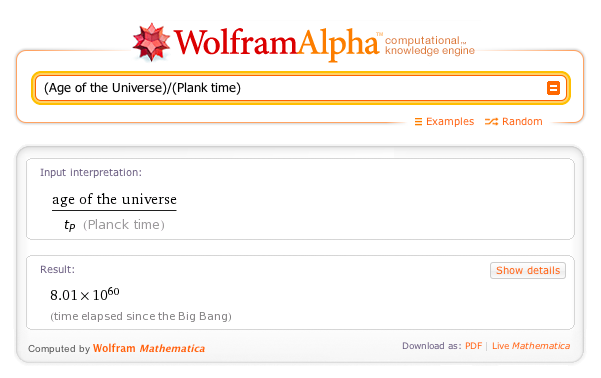
Google+ hangout: 11:00-11:45pm Eastern time, Tuesday-Friday. http://gplus.to/sweetser
This could be an efficient way to exchange a few ideas. If you have a question or two, hangout.
Bet against the Higgs being found,buy the t-shirt
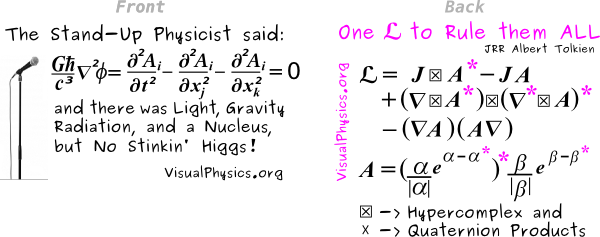
Next Monday/Tuesday: Snarky Puzzle Action Jackson 5





Comments